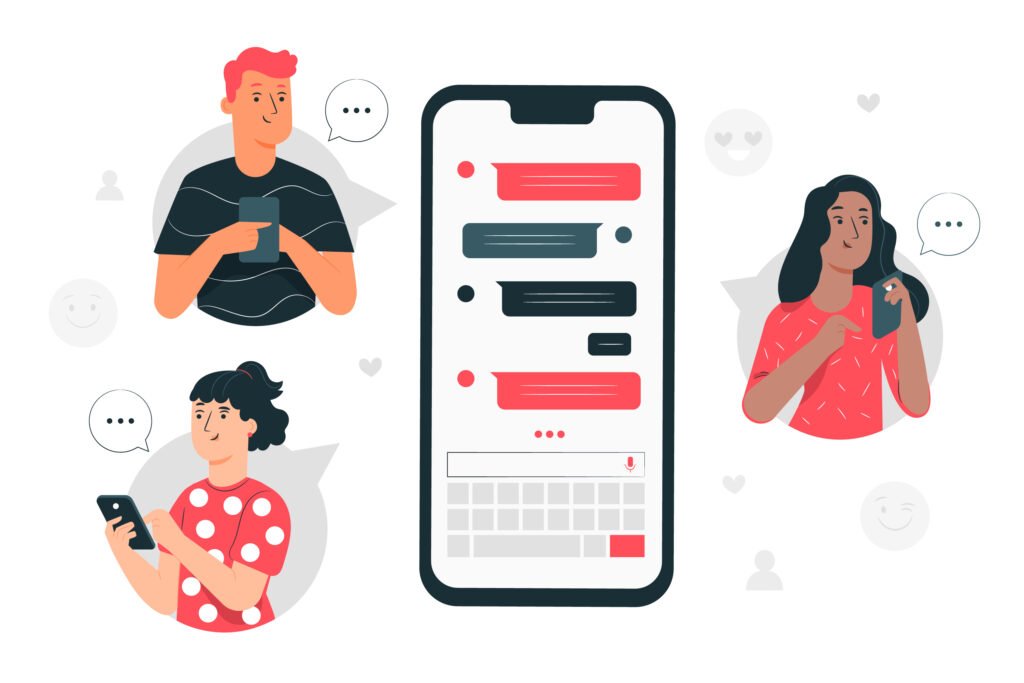
Conversational Marketing is a new, personalized method of doing business online. It moves customers through marketing and sales cornets by using the authority of a time query, a lot like a real-time discussion.
In other words, it’s an automated communication with your website visitors. You can ask them several questions based on their prior answers, so they can deliver you certain details about them.
Key aspects of conversational marketing include personalization, responsiveness, multi-channel engagement, and the ability to gather valuable customer insights. By adopting conversational marketing strategies, businesses can build stronger relationships with customers, increase customer satisfaction, generate leads, and drive conversions.
A Step-by-Step Guide To Effective Marketing Strategies For Business Growth
- Understand Your Customer Journey: Learn everything about your customer’s journey, from the initial touchpoint to the final conversion. Identify key touchpoints where conversational marketing can add value and enhance the customer experience.
- Define Conversational Goals: Choose clear objectives for your conversational marketing campaign. It could be improving lead generation, increasing customer engagement, or providing personalized recommendations. Align your goals with your overall marketing objectives.
- Choose the Right Conversational Tools: Explore innovative conversational tools beyond traditional chatbots. Consider using interactive quizzes, voice assistants, or augmented reality experiences to engage your audience in unique and memorable ways.
- Develop a Conversational Persona: Create a distinct personality for your conversational interactions. This persona should align with your brand voice, values, and target audience. Inject humor, empathy, or relevant cultural references to make the conversations more engaging.
- Craft Compelling Conversation Starters: Create conversation starters that grab attention and encourage interaction. Use intriguing questions, personalized email messages, or interactive prompts to entice users to engage with your conversational marketing efforts.
- Implement Contextual Conversations: Provide context-aware conversations that understand and remember previous interactions. Use data and customer insights to personalize conversations and deliver relevant recommendations or content.
- Integrate Conversations Across Channels: Conversations can be seamlessly integrated into a variety of channels, including website chatbots, social network messaging, email, and even offline interactions. Maintain continuity in conversations, allowing customers to pick up where they left off regardless of the channel they use.
- Leverage User-Generated Content: Incorporate user-generated content into your conversational marketing strategy. Encourage customers to share their experiences, feedback, or testimonials within conversations, fostering a sense of community and authenticity.
- Measure and Optimize: Continuously measure the effectiveness of your conversational marketing efforts. Track metrics like engagement rates, conversion rates, and customer satisfaction. Use this data to refine your conversations, optimize user experiences, and improve outcomes.
- Experiment with Interactive Experiences: Create unique interactive experiences that go beyond text-based communication. To develop dynamic and immersive conversational experiences that capture your audience, experiment with the usage of voice, images, or gamification components.
- Evolve and Stay Agile: Keep up with evolving customer expectations and emerging technologies. Continuously adapt your conversational marketing strategy based on feedback, industry trends, and customer insights. Stay agile and embrace new opportunities to deliver unique and memorable conversational experiences.
Key Benefits Of Conservational Marketing
With conversational marketing, you get the complete information you want from your website visitors. And this happens at the exact period that they engage with your business.
So, here are a few key benefits of conversational marketing,
1. Allows You To Know More About Clients
Naturally, discussions allow you to learn more and gain knowledge about the person you are communicating too, allowing you to obtain information truthfully and frankly.
Conversational instruments such as chatbots are also proficient to monitor users and learn what times of day people prefer to message and what kind of queries people prefer to ask.
2. Discover A New Source Of Leads
Remember, conversational marketing is fascinating and uses chatbots to begin discussions with potential leads. Through human-like interaction, you can initiate to carve lasting connections with these leads and encourage them to communicate with sales reps.
Chatbots are great for selecting your best leads and directing them where mandatory. However, by asking a range of queries, chatbots can specify which leads are most helpful and act accordingly.
3. Develops a Better Human Buying Experience
Buyers often find themselves neglecting the one thing that the online buying experience lacks: human relations. However, conversational marketing is apt to offer this -through intelligent programming and routing, chatbots are able to assist inquiries through real-time discussions.
It acts the same way as a shop assistant, in the sense that they are there willing and waiting for a buyer to approach them as and when they need to.
4. Shortens The Sales Cycle
Implementing conversational marketing into your sales method will shorten your sales cycle. Earlier techniques use lead capture forms, which require the sales rep to get on and reach out to the lead.
Conversations are instant and enable you to make a reply in real-time. Chatbots are also able to regulate the most adequate sales rep and schedule demos all in one chitchat.
5. Long-Term Relationship Building
By offering constant assistance, tailored advice, and timely updates, conversational marketing seeks to develop lasting relationships with customers. It goes beyond transactional interactions, fostering loyalty and advocacy. Businesses prioritize continuous support, promptly addressing inquiries and troubleshooting issues.
Conversational marketing utilizes interactive conversations to gather feedback, understand pain points, and strengthen the bond with customers. Integration of loyalty programs and rewards acknowledges and appreciates loyal customers, encouraging ongoing engagement.
Which Communication Channels Are Best for Conversational Marketing?
Depending on the interests of your target audience and the nature of your organization, conversational marketing can be implemented through a variety of communication channels. The following are some popular methods of communication for conversational marketing.
Chatbots

AI-powered chatbots can be implemented on your website or messaging services to enable automated conversational engagements. In order to help customers, chatbots can answer frequent questions, make suggestions, and collect data.
Voice Assistants

Conversational marketing can now include voice-based engagements thanks to the popularity of voice-activated gadgets like Apple Siri, Google Assistant, and Amazon Alexa. Customer engagement can be improved by voice assistant development and content optimization.
Messaging Apps

Leveraging popular messaging apps such as Facebook Messenger, WhatsApp, or WeChat enables businesses to engage customers on platforms they already use regularly. It allows for personalized conversations, order updates, and customer support.
Website Chat

Implementing a live chat feature on your website allows visitors to engage in real-time conversations with your team. It provides immediate support, answers questions, and guides users through their journey on your website.
SMS (Short Message Service)
Utilizing SMS as a communication channel enables businesses to send personalized text messages to customers. SMS can be effective for appointment reminders, order notifications, and time-sensitive information.
What challenges will businesses face while implementing conversational marketing?
Implementing conversational marketing can pose several challenges for businesses. Here are some key challenges they may face:
- Technical Implementation: Integrating conversational marketing tools, such as chatbots or voice assistants, requires technical expertise and resources. It involves selecting the right marketing platform, configuring it to align with business goals, and ensuring smooth integration with existing systems.
- Natural Language Understanding: Building chatbots or voice assistants that accurately understand and respond to customer queries can be challenging. Natural language processing algorithms need to be trained and refined to handle various language nuances, slang, and context.
- Content and Script Development: Creating engaging and effective conversational content is crucial. Developing scripts or dialogue flows that align with the brand voice, provide valuable information, and guide customers through their journey requires careful planning and continuous optimization.
- Data Integration and Privacy: Conversational marketing collects and analyses customer data. Ensuring proper data integration, storage, and compliance with privacy regulations, such as GDPR or CCPA, is essential to maintaining customer trust and privacy.
- Personalization at Scale: Providing personalized experiences to a large customer base can be challenging. Businesses need to leverage data analytics and segmentation strategies to deliver relevant and tailored conversations to individual customers.
- Balancing Automation and Human Touch: Striking the right balance between automated interactions and human support is crucial. While automation improves efficiency, there are situations where human intervention may be necessary to handle complex queries or provide empathetic customer support.
FAQs
What are the key components of conversational marketing?
Key components of conversational marketing include messaging platforms (e.g., live chat, social media messaging), chatbots, AI-driven assistants, personalized messaging, and real-time analytics.
How does conversational marketing differ from traditional marketing?
Conversational marketing differs from traditional marketing by focusing on personalized, one-to-one interactions rather than mass communication. It leverages messaging channels and automation to engage with customers in real-time and provide tailored experiences.
What are some examples of conversational marketing channels?
Examples of conversational marketing channels include live chat on websites, messaging apps (e.g., WhatsApp, Facebook Messenger), SMS/text messaging, chatbots integrated into websites or social media platforms, and AI-driven assistants.
How can businesses implement conversational marketing strategies?
Businesses can implement conversational marketing strategies by incorporating live chat functionality on their websites, integrating chatbots into messaging channels, personalizing messaging based on customer data, and leveraging automation and AI to streamline interactions.
What are the benefits of conversational marketing for businesses?
Benefits of conversational marketing for businesses include improved customer engagement, increased lead generation and conversions, enhanced customer satisfaction and loyalty, valuable insights into customer preferences and behaviors, and the ability to scale personalized interactions.
How can businesses measure the effectiveness of conversational marketing efforts?
Businesses can measure the effectiveness of conversational marketing efforts by tracking metrics such as response times, engagement rates, conversion rates, customer satisfaction scores, and the number of leads generated or inquiries resolved through conversational channels.
Conclusion
Marketing is all about how you connect with your prospects and how you convince them to make the purchase. And this is why, concepts of conversational marketing have become popular, since it allows interaction with prospects dynamic and engaging. Additionally, it does conversations in the best way that can convert prospects.
Conversational marketing represents a paradigm shift in how businesses engage with their customers in the digital age. By leveraging real-time messaging platforms, chatbots, and AI-driven technologies, conversational marketing enables businesses to deliver personalized, one-to-one interactions that mimic natural conversations.
In today’s digital-first world, where customers expect instant responses and personalized interactions, conversational marketing offers a powerful approach to meet and exceed customer expectations while driving business growth. By embracing conversational marketing strategies and technologies, businesses can stay ahead of the curve and create meaningful connections with their audience in an increasingly competitive landscape.








No Comments